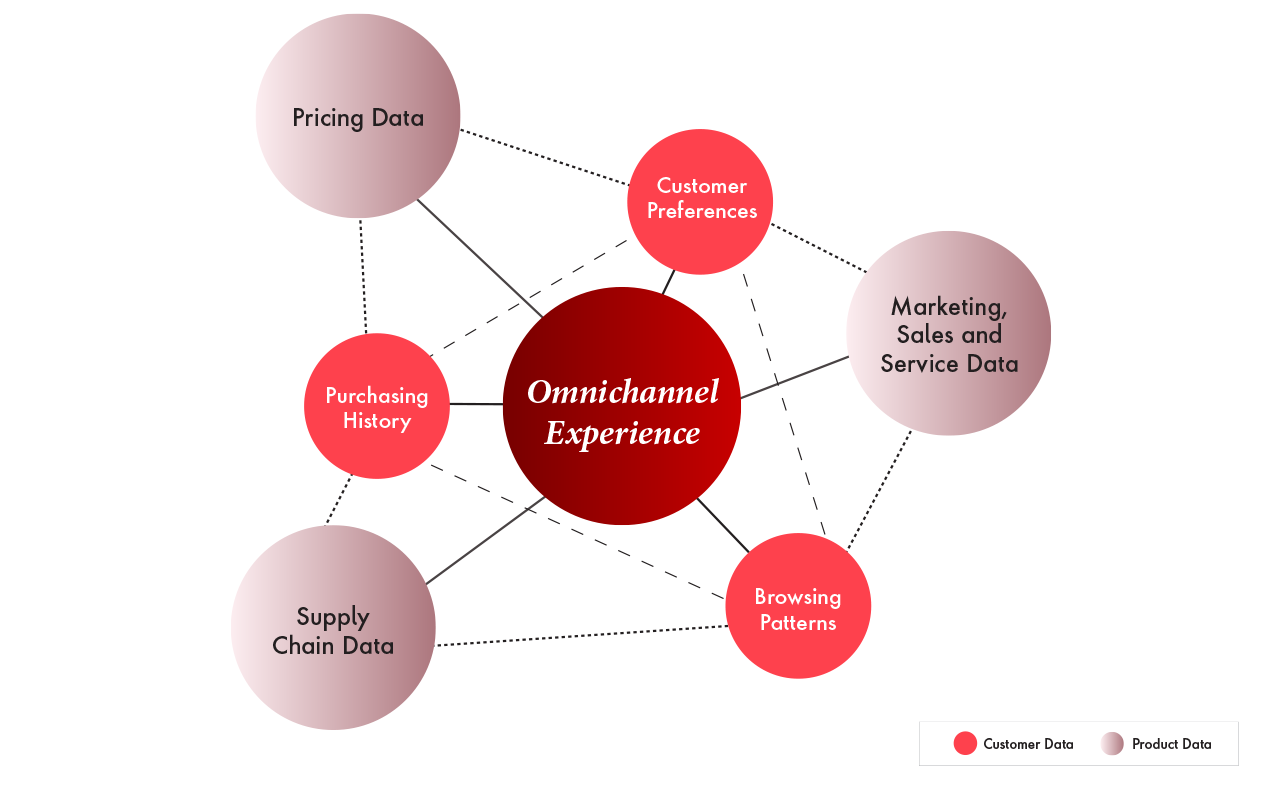What issue can we solve for you?
Type in your prompt above or try one of these suggestions
Suggested Prompt



Why an Omnichannel Data Ecosystem Is the Ultimate Commerce Hack
Why an Omnichannel Data Ecosystem Is the Ultimate Commerce Hack
Customers expect it. Business value hinges on it. But after three decades of digital commerce, brands still struggle to get omnichannel right. Developing an omnichannel data ecosystem can make all the difference.
A flashpoint for omnichannel data
Omnichannel isn’t just a buzzword; it’s the holy grail of modern commerce. Brands that deliver are reaping massive rewards. Those with strong omnichannel strategies retain nearly 90 percent of their customers. And the payoff doesn’t stop there—omnichannel customers drive 30 percent higher lifetime value. The message is undeniable: adapt to omnichannel or get left behind.
Yet, channel proliferation is making omnichannel commerce harder to execute. Customers’ path to purchase is expanding fast—from in-store, online and mobile to marketplaces, quick commerce, social, live and more. Forty-six percent of retailers say their e-commerce mix is less profitable than their store offering. More channels mean even more profitability challenges. But it also means more opportunities to maximize the impact of data for e-commerce.
Given this environment, brands must finally crack the code on omnichannel. The answer is data. It’s not about the quantity of data—brands are swimming in it. Winning at omnichannel commerce is knowing when to use the right data and connecting it at the right time to make meaningful connections with customers, however they shop. This is what an omnichannel data ecosystem helps brands do.
Why omnichannel data matters
Commerce is about understanding who customers are, what they need—and what they don’t yet realize they need. So, it’s no surprise that data that reveals these insights is essential for delivering personalized, cohesive omnichannel experiences.
In addition to rich first-party data, brands need zero-party and third-party data. Gaps exist here even in the retail industry, which is celebrated as a commerce disrupter. Only 40 percent of retailers are creating 360-degree views of customers using transactions, site behaviors, profile demographics, impressions or third-party data, according to a research study we conducted with Adobe.
Analyzing behavioral data on customer preferences, purchasing history and browsing patterns is pure gold. Brands can use this data to tailor recommendations, promotions and customer journeys across channels. Done right, this omnichannel data orchestration fuels relevance and engagement in the near term and customer loyalty over the long term. At the same time, it prevents misfires that disrupt the seamless journey to purchase—the redundant, irrelevant or disconnected offers and experiences that cause unnecessary friction for customers as they move from one channel to another and back again.
The great omnichannel data disconnect
Despite how important 360-degree customer data is, here’s the irony: Brands, particularly B2C brands, often overindex on customer-focused data at the exclusion of robust, contextualizing product data when it comes to omnichannel data orchestration.
Product data goes beyond what resides in the product information management system. It includes product specifications and any contextual data that isn’t directly related to the customer. This is pricing data, supply chain data and marketing, sales and service data. It also includes competitive intelligence and data on macroeconomics, weather and current events.
What happens when customer and product data are isolated from each other? Imagine a grocery store launches private-label organic products and strategically micro-targets loyalty customers who purchase organic products with special promotional discounts across channels. But when customers shop, the advertised products are out of stock, stuck in distribution centers miles away. The store substitutes the missing SKUs with higher-priced products, destroying margins.
Or imagine a software solutions provider has a longstanding relationship with a large corporation. The provider knows the company orders software during annual planning. The account relationship manager offers a bulk promotion on the latest version, promising speedy delivery. But the software release is pushed back due to third-party vendor delays. The only thing that comes on time is an apology email.
In both of these instances, omnichannel execution is horribly broken. Brands know what’s relevant for their customers—that’s not the problem. However, they’re unable to deliver on the omnichannel promise because of the disconnect between customer and product data.
This disconnect typically happens because customer data is located, managed and updated very differently than product data. The data is isolated in different B2C databases or B2B data platforms, and writing business rules to bring them together is nearly impossible. Technology complexity often makes things worse. Many brands have grown through acquisition and are encumbered by massive tech debt—a sea of point solutions that don’t communicate with each other.
Data for e-commerce: from isolation to insight
The inability to connect data has brands working in the dark. For example, it’s difficult to develop omnichannel strategies or confidently know which channels to invest in. Brands miss out on cross-selling and upselling opportunities. They’re plagued by stockouts or overstock. And because they can’t meet customers where they are with what they need, conversion rates suffer.
Working in this disjointed way isn’t sustainable. Customer expectations, competitive pressures and the dynamic nature of commerce in the era of AI make this clear. The good news is brands can bring customer data and product data together in an omnichannel data ecosystem to leverage the interdependencies between them.

The omnichannel data ecosystem connects 360-degree customer views with 360-degree product views. Brands can work from the “outside-in” to understand demand, purchase intent and customer behaviors across channels, ensuring that products are available for purchase. At the same time, they can work from the “inside-out,” reducing stock and optimizing sales by influencing customer demand and conversion with omnichannel offers and promotions.
Falabella, a South American retailer that sells fashion, food, home and technology products, learned how this works firsthand. The company has a diversified product portfolio, multiple sales channels and operates across rural towns and urban centers. All of this complicates supply chain logistics, especially last-mile fulfillment. The retailer created an omnichannel data ecosystem for B2C data by standing up a customer data lake and a supply chain data lake. By using AI, advanced data modeling and data analytics for e-commerce, the company is bringing data insights together to tailor offers to customers across channels and geographies.
Sonepar, the leading omnichannel B2B distributor of electronic products, solutions and services, developed an omnichannel platform called Spark. Operating like an omnichannel data ecosystem, Spark is transforming the relationship between Sonepar’s associates and customers. The platform enables a seamless omnichannel experience, from online product catalogs to streamlined ordering. And it’s always improving. By acting on platform data insights and customer feedback, Sonepar is continually adapting customer experiences and offers, while making it easier for its associates to fulfill orders.
The nonnegotiables of an omnichannel data ecosystem
These companies invested strategically in an omnichannel data ecosystem to strengthen omnichannel experiences. While it’s not easy to know where to begin and what to prioritize, there are several nonnegotiables.
Data readiness: Poor data quality creates a “garbage in, garbage out” cycle. The effectiveness of omnichannel commerce hinges on data quality—a truth that’s increasingly evident with the rapid advancement of AI. Whether it’s experience, supply chain data, B2C data or e-commerce data, all data must be simplified and standardized. Brands can turn to a data factory to orchestrate and syndicate data, de-duping it, aggregating it strategically with the right attributes and organizing it to respond to customer and market signals in real time. Data governance is key to data readiness as it codifies access controls and addresses data privacy.
Composable architecture: Monolithic architectures lack the flexibility, agility, scalability and integration capabilities to manage data consistently across channels in today’s ever-changing commerce landscape. What’s needed are MACH (microservices-based, API-first, cloud-native and headless) technology solutions that enable composable commerce. Brands can easily create new buying experiences and channels. APIs power real-time data exchange, unlike traditional data feeds. And a cloud-native architecture makes data available (with access controls) across the partner ecosystem, which is often a missing link in omnichannel.
Single source of truth: While all the functional areas of the business involved in commerce will, by definition, use customer and product data insights for different purposes, a single source of truth should connect them. A composable architecture provides the technical backbone for this. But human behavior must also change. “Going rogue” with solutions that create alternative sources of truth causes unnecessary confusion and complexity—and risks brands’ ability to deliver a consistent omnichannel experience.
Unstructured data: Because it doesn’t fit into traditional databases, companies often undervalue and underutilize unstructured data, such as customer reviews, social media content, call center transcripts and chatbot interactions. But the context that these data sources provide can reveal hidden trends, anticipate customer needs and even inform product development. That’s why it’s key to include unstructured data in the omnichannel data ecosystem and invest in advanced analytics and AI-powered tools to uncover insights from masses of data quickly.
More action, less analysis: As brands look to invest in the tools and technologies to support their omnichannel data ecosystem, it’s easy to get stuck in an analysis paralysis spiral of assessing solution after solution to find the perfect one. It’s essential to resist the spiral and get to action quickly. Brands can work with agency and systems integrator partners to define their omnichannel data ecosystem strategy and roadmap, identifying immediate wins. The best approach? Be evolutionary, not revolutionary. Very few brands are in the position to solve their data problems all at once given the complexity of challenges associated with legacy systems and ingrained ways of working around data for e-commerce.
Designed to deliver on the promise of omnichannel data
With a solid foundation for their omnichannel data ecosystem, brands can build from there to amplify its impact in several important ways.
Getting granular can supercharge omnichannel commerce. Commerce is about human connection. When it comes to data, brands can strengthen this connection with zero-party data that customers share themselves. It goes far beyond designing journeys from buyer personas. Most customers know there is a value exchange associated with their data. They share it expecting something in return. To get more zero-party data, brands must identify the right moment in the customer journey for the exchange—and the value proposition that incentivizes participation. Regarding product data, granularity is about localization. This is how brands can surgically target the alignment of inventory positions and promotions with customer behavior and demand across channels.
Monetizing data creates a flywheel effect of impact. Brands that build effective omnichannel data ecosystems with rich first-party data are well positioned to take advantage of data monetization opportunities. They develop new offerings for the advertisers they work with, creating high-margin revenue streams. At the same time, brands increase connections with customers through intelligent offers and experiences and curated product promotions across channels. Done right, commerce media networks create a flywheel effect—a self-reinforcing cycle of continuous improvement of the commerce business. And it all starts with data.
Always optimizing is essential because commerce is a moving target. Adapting to change is important for optimizing data in commerce. For example, AI readiness is nonnegotiable. AI can cut through the data complexity that overwhelms humans. It puts accurate, consistent and real-time data at humans’ fingertips so they can make intelligent decisions. Think of it like this: Commerce teams could spend hours sifting through spreadsheets to decide to send ice scrapers to Denver on Thursday. Or they could get an AI-generated report that shows an 85 percent chance of snow on Thursday in Denver. The report also confirms that 20,000 ice scrapers in the U.S. West distribution center can be delivered to the city’s top 10 revenue-producing hardware stores by the end of business on Tuesday.
Data for e-commerce: It all comes down to connections
Buzzword or not, omnichannel is a struggle for brands across industries. But omnichannel data ecosystems can change this. Forget the pressure of customer demands, channel explosion, technology advancement and competitive maneuvering for a moment. Creating an omnichannel data ecosystem reflects a simple proposition that’s innate to commerce: connection.
By understanding customers in the real-time context of products, inventory, promotions and external influences, brands can make stronger and more meaningful connections with people consistently across channels. Every touchpoint. Every journey. Every time. That’s good for customers, and the top line too.








